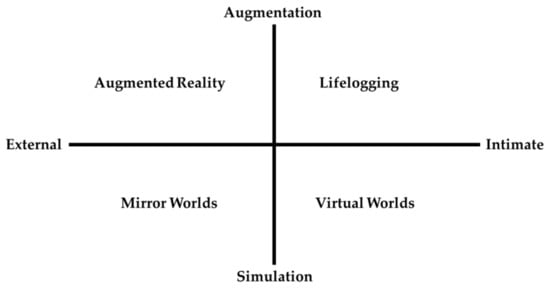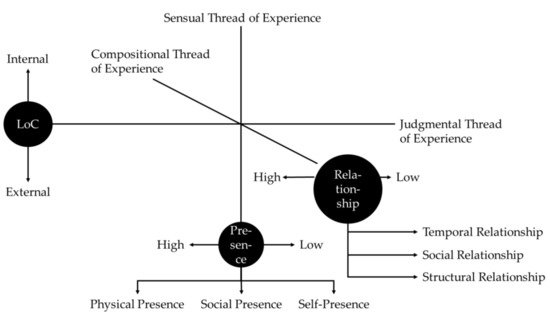You're using an outdated browser. Please upgrade to a modern browser for the best experience.
Please note this is a comparison between Version 2 by Nora Tang and Version 1 by Sungjin Park.
The metaverse is expected to turn imagination into reality through the convergence of various technologies and should be considered as a medium for sustainable education, free from the constraints of time and space.
- gameful experience
- motivation
- experience
- metaverse
1. Metaverse
Metaverse combines “meta,” meaning virtual and transcendent, and “verse,” referring to the world and universe. The word first appeared in the novel Snow Crash published in 1992 [11][1]. Metaverse was being developed based on virtual reality before the COVID-19 pandemic, but attracted renewed attention once it struck to meet the limitations of external activities and individual needs. It is a rapidly expanding concept.
Acceleration Studies Foundation (ASF), a non-profit technology research organization, published a metaverse road map in 2007 and presented four classification criteria for metaverse (Figure 31). According to ASF [12][2], the x-axis in Figure 31 indicates the direction of technology while implementing the metaverse. This distinguishes whether it is a technology that projects information from the real world in which metaverse users live or a technology that is implemented by focusing on the identity of the user or object, and their inner world. The y-axis indicates whether the technology improves the quality of lives by adding new functions in the real world of users or creates new values by implementing realistically impossible things in a completely new virtual world.
-
Augmented Reality: A method of projecting information using a device in a way such that it provides additional information using a smartphone or smart device in the real world.
-
Mirror Worlds: A space that provides new information or activities to users by creating a space identical to the real world in the virtual world.
-
Virtual Worlds: A virtual space where users can move their avatars based on 3D graphics.
-
Lifelogging: A virtual space in which data and actions occurring in reality are transferred to the virtual world as they are.
Duan et al. [11][1] implemented a metaverse in a university campus by creating a virtual space using the metaverse platform to examine the behavior of students engaged in it. As a result, a simple economic system or democratic activity was guaranteed even within the metaverse.
According to the classification by ASF [12][2], representative metaverse platforms including Zepeto, Roblox, Gather.town, and Fortnite can be classified as “virtual worlds” (Figure 42). The four metaverse platforms provide a user experience based on a 3D graphic environment and a studio program, which serves as a world development tool. Users create their own virtual playgrounds by customizing the virtual world using the studio tool.
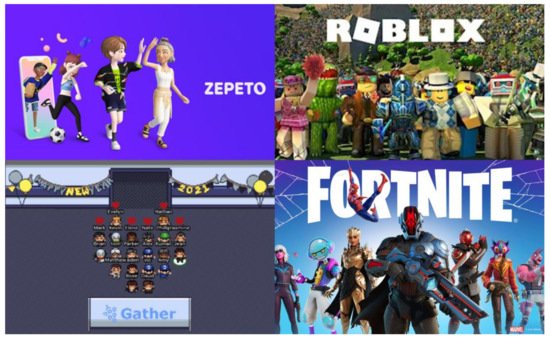
Figure 42.
Screenshots of major metaverse platforms.
The four metaverse platforms identified in Figure 42 were found to have a large number of users globally. There are cases of private companies using the metaverse to promote their products or services, as well as celebrity performances. As such, the most user-accessible form of metaverse is currently the virtual world.
2. Experience
Experience is not a clearly defined word, but it can be understood in a specific context. The concept is used in various fields such as education, sociology, and management. It originates from certain types of mental consciousness, such as perception and sensation which provides an individual with the awareness of being present [13][3]. If the existing academic definition of experience is approached broadly, it includes events caused by various mental states such as dreaming and thinking [13][3]. Therefore, it is difficult to define experience, and various perspectives in each field explain it differently [10][4].
Kim [10][4] used three threads to classify individual experiences by analyzing previous studies that approached experience philosophically. Kim presented a framework for categorizing personal experiences from various perspectives, such as the experience gained through personal sensory experience and interaction and the experience of the physical space in which the individual is located (Figure 53).
The first criterion is the sensual thread of experience that indicates an experience that can be felt using the human senses. It is a concrete and practical experience that responds to external stimuli. The characteristic of the sensual thread of experience is that it consists of a sense of presence (SoP), which is a psychological state that makes an individual have the feeling of “being there”. Accordingly, when an individual has a sensual thread of experience, its degree felt by an individual varies according to whether the presence is high or low.
- Agreeableness: An individual factor that helps others or expects to receive help from others.
-
Neuroticism: An individual factor related to inner self management, such as fear, sadness, embarrassment, distrust, or difficulty in managing stress.
-
Emotional stability: An individual component that is the opposite of neuroticism.
- Physical Presence: This is a state in which one can feel the existence of a specific target that can be physically experienced. For instance, how realistic the equipment worn by the character or an environment in the virtual world feels can be expressed to give a sense of the physical presence.
- Social Presence: This is the element that one experiences when they recognize a connection with another person. Conversation with others through online social networking services corresponds to social presence.
-
Self-presence: This is an experience that allows an individual to feel their presence in a specific situation or environment. It is an element the individual can feel when they interact with something else or exercise influence.
The second criterion is the judgmental thread of experience. This refers to all experiences that occur when judgments made by an individual affect not only internal emotions but also the external environment. The key element of the judgmental thread of experience is locus of causality (LoC). Locus of causality is an extended concept of locus of control used in psychology and organizational behavior. It refers to the qualitative degree to which one can exercise influence by controlling a specific event. Locus of causality is divided into the following.
-
Intrinsic LoC: This refers to a situation in which an individual directly participates and has direct control over the surrounding environment, members, or constituents.
-
Extrinsic LoC: This is an element that cannot be directly controlled by the surrounding situation, members, or components, but is controlled by other people or systems, or is an element that can be felt on using something that has been completed.
The third criterion is the compositional thread of experience. The compositional thread of experience refers to the elements that make up the experience. For instance, friends who went fishing together and the equipment used, or friends who exercised together on the school yard and the ball, are elements of the compositional thread of experience. The compositional thread of experience is divided into cohesion of time, social relationship, and structural relationship based on the relationship between experience elements.
-
Cohesion of temporal relationship: This refers to the structure of a completed experience in which the elements are arranged in a time series order. It is a key element in experiences that are universally organized in a sequence of actions and outcomes.
-
Cohesion of social relationship: This is an experience structure in which an individual and others are socially connected in an experience.
-
Cohesion of structural relationship: This refers to the structural relationship that is formed not only with people but also with various relational objects such as products, services, and structures in experience.
3. Gameful Experience and Motivation
When a game-like experience is created using game elements such as game mechanics and game rules in a non-game context, it is called a gameful experience [14][6]. A gameful experience delivers enjoyment, absorption, creative thinking, absence of negative affect, activation, and dominance to users, thus increasing user loyalty and participation [14][6]. Furthermore, it is not considered a gaming experience because it creates a game-like experience but in a non-game context, while gaming experience refers to what an individual feels after playing an actual game [6][7].
Gameful experience is considered to be effective for education because of the following five attributes of experience it promotes, as suggested by Dewey [15][8], including continuity, interaction, interest, growth, and educational experience. Figure 64 illustrates the basic learning structure in education when gamification is applied [16][9].
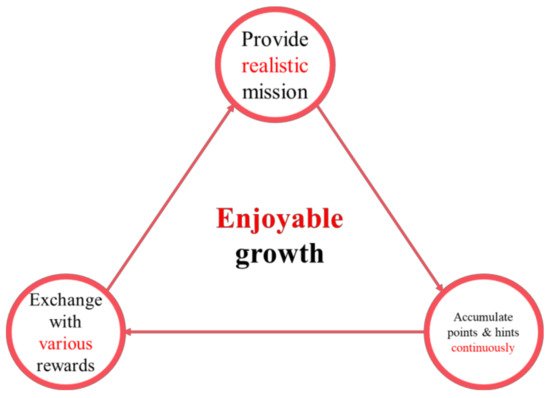
For sustainable learning, the instructor provides learners with missions/quests continuously for a fixed or variable duration. The learners master or expand the knowledge they have accumulated while solving the missions/quests they face. At the same time, instructors set learning goals through missions/quests [17][10]. The process of the learners solving the mission/quest is not a simple “repetition” of knowledge but a continuous expansion of knowledge. The learner who successfully solves the mission/quest receives a reward from the instructor. The reward has various forms such as points or privileges and benefits that help other learning activities. In the point, badge, and leaderboard (PBL) system, when learners fulfill a mission/quest, they receive points, and the points are displayed on the leaderboard, promoting the learner’s learning motivation. In addition to the PBL system, other types of games such as the room escape game and big game provide other rewards, facilitating learning activities. The learner exchanges the rewards obtained by fulfilling missions/quests for various practical rewards. The reward is exchanged by the learner for benefits, rights, and virtual goods, which directly or indirectly affects learning activities. The exchanged reward induces interaction with the instructor or other learners and exerts influence.
Classcraft (Figure 75) is presented as an example for Figure 64. Classcraft is a learning operation platform where individual students can create their own avatar and choose their own profession. Warrior, wizard, and healer are representative occupations. Learners earn points each time they solve the problems presented by the instructor. The points are used to attain unique skills. Each occupation has its own unique skills. Examples of unique skills include controlling air conditioning, eating in class, and nullifying one tardy moment. They do not violate school rules and are enough of a privilege to exert an appropriate level of influence on other learners.
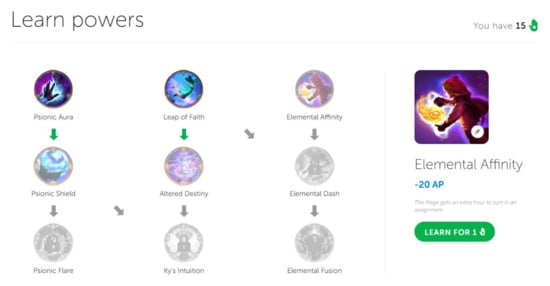
Figure 75.
Classcraft’s skill cases.
The instructor constructs a learning cycle structure for the learner’s sustainable learning so that the learner is continuously drawn to learning activities. In addition, in this process, the learning experience is expanded by inducing interactions between learners, between learners and teachers, and between learners and the educational environment. The game rules or game mechanics set by the instructor arouse the interest of the learners. In particular, the game mechanics induce affordance by stimulating six individual factors in the learners that induce sustainable learning [18][11]. The six factors are:
-
Conscientiousness: An individual factor that actively plans or organizes tasks and draws results.
- Extraversion: An individual factor that promotes finding new opportunities or interests.
- Imagination/Openness: An individual factor that helps in inventing new and original ideas, having unconventional values, or questioning authority.
The learner’s sustainable educational growth is achieved because the gameful experience is expanded into the learning experience [19][12]. Through self-reflection on what the individual felt during learning activities, interactions with other learners, the instructor, and the educational environment, and their own values and growth, the learner feels the experience of “learning” based on the experience elements of Kim [10][4]. The gameful experience extends to the learning experience and has a positive effect on the learner’s learning motivation.
References
- Duan, H.; Li, J.; Fan, S.; Lin, Z.; Wu, X.; Cai, W. Metaverse for social good: A university campus prototype. In Proceedings of the 29th ACM International Conference on Multimedia; Virtual Event, Lisboa, Portugal, 20–24 October 2021; pp. 153–161.
- Smart, J.M.; Cascio, J.; Paffendorf, J. Metaverse Road Map; Acceleration Studies Foundation: Ann Arbor, MI, USA, 2007.
- Borchert, D.M. The Encyclopedia of Philosophy, 2nd ed.; GALE: Farmington Hills, MI, USA, 2006.
- Kim, J. Design for Experience: Where Technology Meets Design and Strategy; Springer: Berlin/Heidelberg, Germany, 2015.
- Huotari, K.; Hamari, J. A Definition for Gamification: Anchoring gamification in the service marketing literature. Electron. Mark. 2017, 27, 21–31.
- Dicheva, D.; Dichev, C.; Agre, G.; Angelova, G. Gamification in education: A systematic mapping study. J. Educ. Technol. Soc. 2015, 18, 75–88.
- Eppmann, R.; Bekk, M.; Klein, K. Gameful experience in gamification: Construction and validation of a gameful experience scale . J. Interact. Mark 2018, 43, 98–115.
- Dewey, J. Experience and Education. Educ. Forum 1986, 50, 241–252.
- Park, S.; Kim, S. Is sustainable online learning possible with gamification?—The effect of gamified online learning on student learning. Sustainability 2021, 13, 4267.
- Guinote, A.; Kim, K.H. Power’s Mission: Impact and the quest for goal achievement. Curr. Opin. Psychol. 2020, 33, 177–182.
- Jia, Y.; Liu, Y.; Yu, X.; Voida, S. Designing Leaderboards for Gamification: Perceived Differences Based on User Ranking, Application Domain, and Personality Traits. In Proceedings of the 2017 CHI Conference on Human Factors in Computing Systems, New York, NY, USA, 6–11 May 2017; pp. 1949–1960.
- Majuri, J.; Koivisto, J.; Hamari, J. Available online: https://www.researchgate.net/publication/327438074_Gamification_of_Education_and_Learning_A_Review_of_Empirical_Literature (accessed on 1 December 2021).
More

